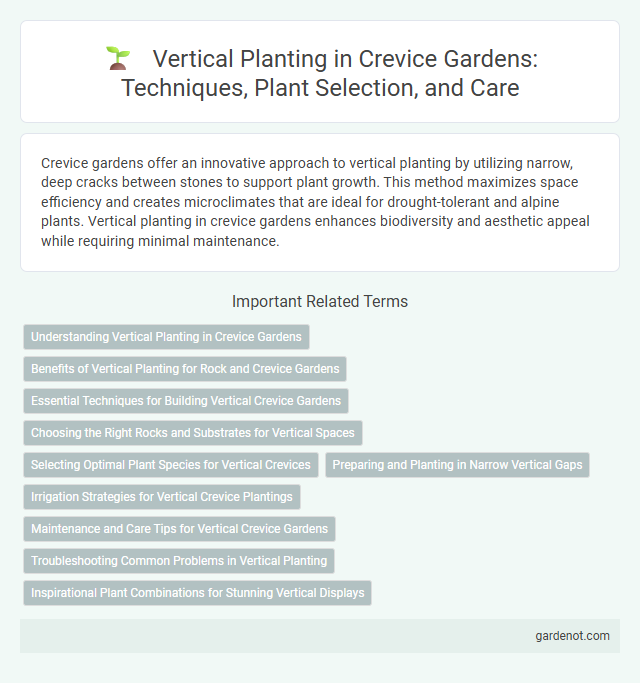Crevice gardens offer an innovative approach to vertical planting by utilizing narrow, deep cracks between stones to support plant growth. This method maximizes space efficiency and creates microclimates that are ideal for drought-tolerant and alpine plants. Vertical planting in crevice gardens enhances biodiversity and aesthetic appeal while requiring minimal maintenance.
Understanding Vertical Planting in Crevice Gardens
Vertical planting in crevice gardens maximizes space by utilizing narrow, deep gaps between rocks to support diverse plant species. This method replicates natural alpine environments, promoting strong root development and efficient water drainage. Selecting drought-tolerant, low-maintenance plants like sedums and saxifrages enhances the ecological balance and aesthetic appeal of these vertical habitats.
Benefits of Vertical Planting for Rock and Crevice Gardens
Vertical planting in rock and crevice gardens enhances space efficiency by maximizing the planting area on limited surfaces. It improves air circulation around plants, reducing the risk of fungal diseases and promoting healthier growth. Furthermore, vertical arrangements create striking visual interest by showcasing diverse plant textures and colors along the garden's vertical planes.
Essential Techniques for Building Vertical Crevice Gardens
Vertical crevice gardens require precise stone selection and arrangement to mimic natural rock formations, allowing plants to thrive in narrow gaps with optimal drainage and airflow. Essential techniques include layering stones to create microclimates, ensuring stability for climbing or root-anchored plants, and positioning the garden to maximize sunlight exposure. Proper soil composition and consistent moisture management further enhance plant growth within these vertical structures.
Choosing the Right Rocks and Substrates for Vertical Spaces
Selecting the right rocks and substrates is crucial for successful vertical planting in crevice gardens. Choose porous, weather-resistant rocks like limestone or sandstone that retain moisture without waterlogging root zones. Use lightweight, well-draining substrates such as gritty sand mixed with organic matter to support plant roots and facilitate aeration in vertical crevices.
Selecting Optimal Plant Species for Vertical Crevices
Selecting optimal plant species for vertical crevices requires prioritizing those with shallow root systems and high drought tolerance, such as sedums, ferns, and alpine plants. These species thrive in narrow, well-drained spaces and withstand fluctuating moisture levels. Incorporating native and low-maintenance plants enhances sustainability and reduces irrigation needs in vertical crevice gardens.
Preparing and Planting in Narrow Vertical Gaps
Preparing narrow vertical gaps for crevice gardens involves thoroughly cleaning the space to remove debris and ensuring proper drainage by adding a layer of small stones or gravel. Planting in these vertical gaps requires selecting drought-tolerant, shallow-rooted plants such as sedums, succulents, or alpine species that thrive in minimal soil and tight spaces. Careful insertion of soil pockets and securing plants firmly promotes healthy growth while mimicking natural rocky habitats, enhancing both aesthetics and biodiversity in the crevice garden.
Irrigation Strategies for Vertical Crevice Plantings
Efficient irrigation strategies for vertical crevice gardens prioritize drip or micro-spray systems to deliver consistent moisture directly to root zones, minimizing water waste and preventing fungal diseases. Selecting drought-tolerant plants specialized for crevice environments enhances water retention and reduces irrigation frequency. Incorporating moisture sensors and automated timers optimizes water use by adjusting irrigation based on real-time soil moisture levels and weather conditions.
Maintenance and Care Tips for Vertical Crevice Gardens
Vertical crevice gardens require regular monitoring to ensure plants receive adequate water, as their narrow soil pockets can dry out quickly. Pruning is essential to prevent overcrowding and maintain airflow, reducing the risk of disease. Fertilize sparingly with a balanced, slow-release fertilizer to support healthy growth without encouraging excessive foliage.
Troubleshooting Common Problems in Vertical Planting
Vertical planting in crevice gardens can face challenges such as inadequate drainage, leading to root rot or fungal diseases. Ensuring proper soil composition with well-draining substrates like gritty sand or pumice mitigates moisture retention issues. Regular inspection for pest infestations, such as aphids or spider mites, and timely intervention with organic insecticides help maintain plant health and vertical garden stability.
Inspirational Plant Combinations for Stunning Vertical Displays
Combining ferns with trailing ivy and flowering begonias creates visually rich vertical planting arrangements that thrive in shaded crevice gardens. Succulents paired with vibrant sedums and drought-tolerant thyme form striking, low-maintenance displays perfect for sunny, rocky walls. Mixing trailing nasturtiums with clinging clematis and bright geraniums adds color and texture, enhancing the natural beauty of vertical crevice garden spaces.
Vertical planting Infographic

 gardenot.com
gardenot.com